Child Labour: A Comprehensive Report on Global Societal Impact
VerifiedAdded on 2023/01/16
|11
|3969
|24
Report
AI Summary
This report provides a comprehensive analysis of child labour, examining its definition, causes, and detrimental impacts on children's physical, mental, and emotional development. It explores the current global situation, highlighting the conditions faced by children involved in labour and differentiating between paid labour and exploitative practices. The report delves into the historical, present, and future dimensions of child labour, considering factors such as poverty, lack of education, and societal norms. It further investigates current policies and the role of legislation in preventing child labour, including ethical implications and recommendations for breaking down barriers. The report underscores the importance of education, improved financial stability, and stricter legal frameworks to address this critical social issue, ultimately aiming to provide better opportunities and protect the rights of children worldwide. This report is a valuable resource available on Desklib, a platform offering AI-powered study tools and resources for students.
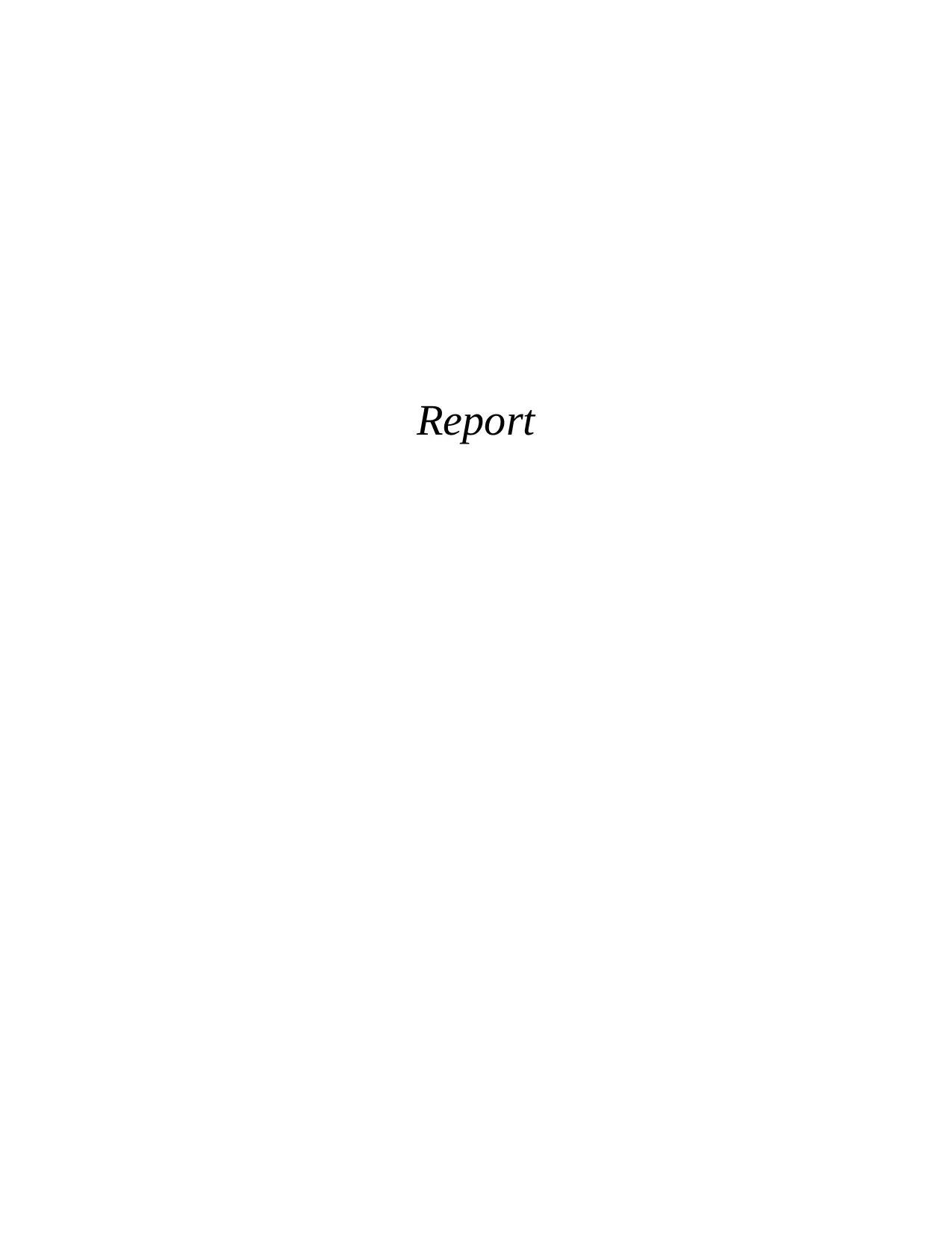
Report
Paraphrase This Document
Need a fresh take? Get an instant paraphrase of this document with our AI Paraphraser
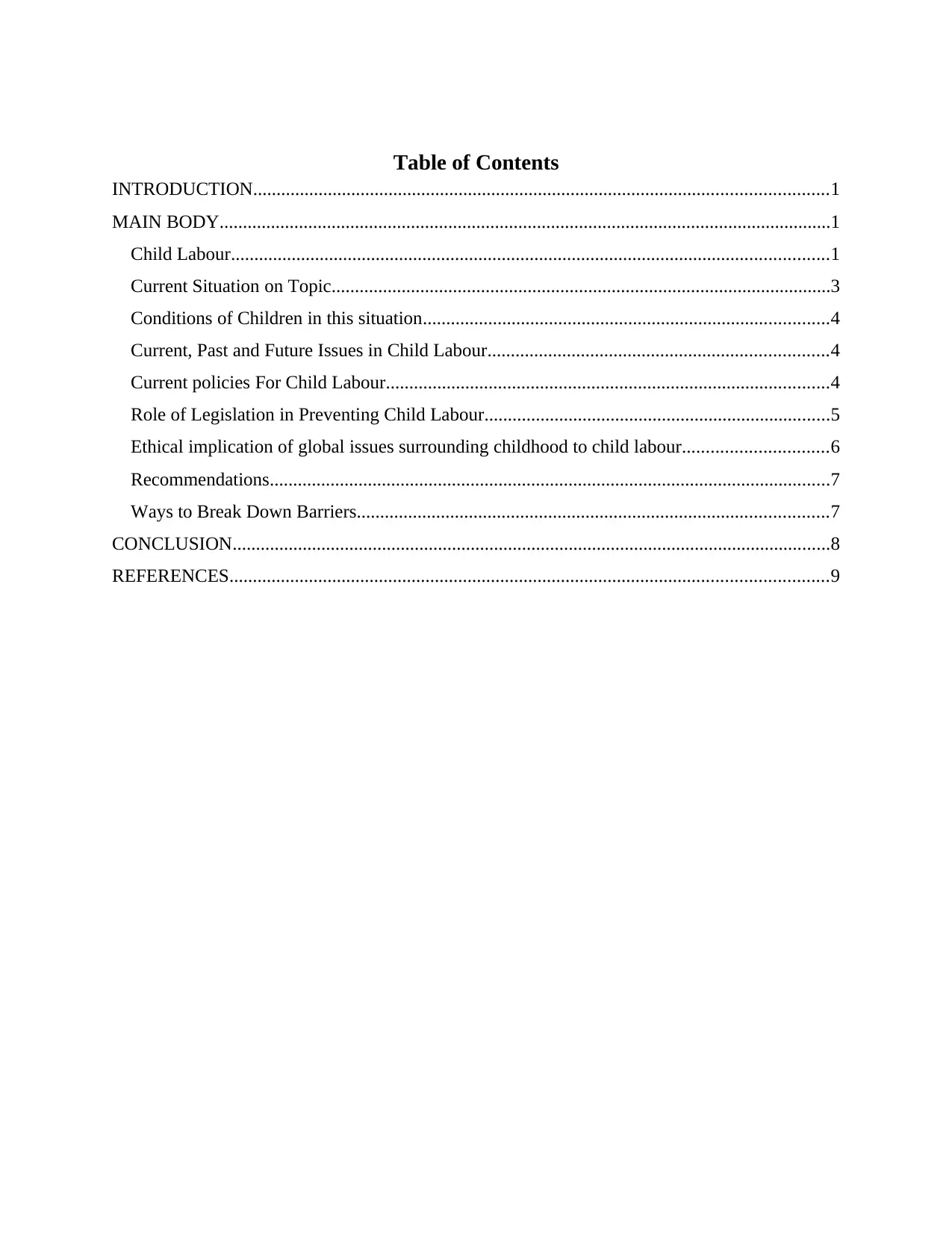
Table of Contents
INTRODUCTION...........................................................................................................................1
MAIN BODY...................................................................................................................................1
Child Labour................................................................................................................................1
Current Situation on Topic...........................................................................................................3
Conditions of Children in this situation.......................................................................................4
Current, Past and Future Issues in Child Labour.........................................................................4
Current policies For Child Labour...............................................................................................4
Role of Legislation in Preventing Child Labour..........................................................................5
Ethical implication of global issues surrounding childhood to child labour...............................6
Recommendations........................................................................................................................7
Ways to Break Down Barriers.....................................................................................................7
CONCLUSION................................................................................................................................8
REFERENCES................................................................................................................................9
INTRODUCTION...........................................................................................................................1
MAIN BODY...................................................................................................................................1
Child Labour................................................................................................................................1
Current Situation on Topic...........................................................................................................3
Conditions of Children in this situation.......................................................................................4
Current, Past and Future Issues in Child Labour.........................................................................4
Current policies For Child Labour...............................................................................................4
Role of Legislation in Preventing Child Labour..........................................................................5
Ethical implication of global issues surrounding childhood to child labour...............................6
Recommendations........................................................................................................................7
Ways to Break Down Barriers.....................................................................................................7
CONCLUSION................................................................................................................................8
REFERENCES................................................................................................................................9
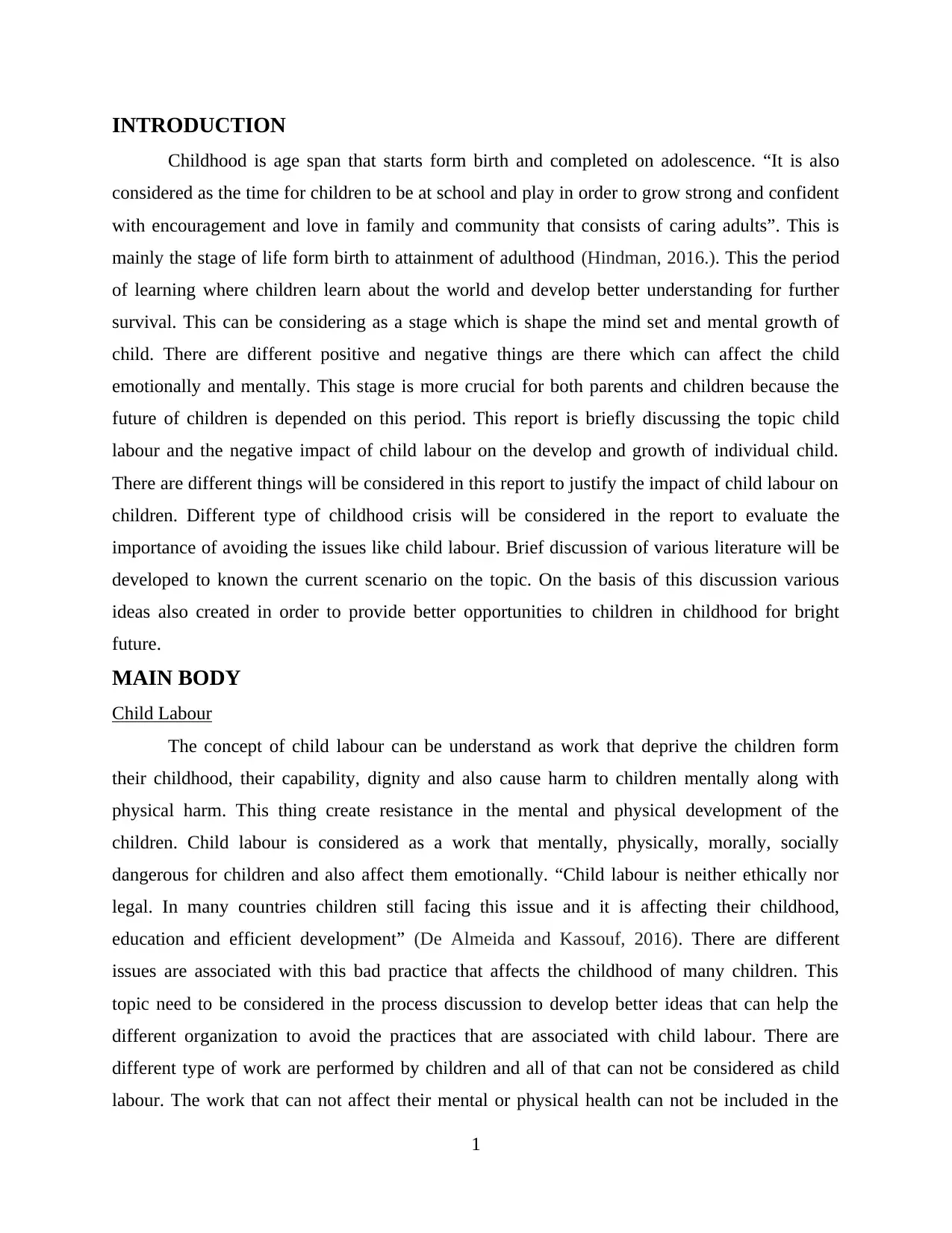
INTRODUCTION
Childhood is age span that starts form birth and completed on adolescence. “It is also
considered as the time for children to be at school and play in order to grow strong and confident
with encouragement and love in family and community that consists of caring adults”. This is
mainly the stage of life form birth to attainment of adulthood (Hindman, 2016.). This the period
of learning where children learn about the world and develop better understanding for further
survival. This can be considering as a stage which is shape the mind set and mental growth of
child. There are different positive and negative things are there which can affect the child
emotionally and mentally. This stage is more crucial for both parents and children because the
future of children is depended on this period. This report is briefly discussing the topic child
labour and the negative impact of child labour on the develop and growth of individual child.
There are different things will be considered in this report to justify the impact of child labour on
children. Different type of childhood crisis will be considered in the report to evaluate the
importance of avoiding the issues like child labour. Brief discussion of various literature will be
developed to known the current scenario on the topic. On the basis of this discussion various
ideas also created in order to provide better opportunities to children in childhood for bright
future.
MAIN BODY
Child Labour
The concept of child labour can be understand as work that deprive the children form
their childhood, their capability, dignity and also cause harm to children mentally along with
physical harm. This thing create resistance in the mental and physical development of the
children. Child labour is considered as a work that mentally, physically, morally, socially
dangerous for children and also affect them emotionally. “Child labour is neither ethically nor
legal. In many countries children still facing this issue and it is affecting their childhood,
education and efficient development” (De Almeida and Kassouf, 2016). There are different
issues are associated with this bad practice that affects the childhood of many children. This
topic need to be considered in the process discussion to develop better ideas that can help the
different organization to avoid the practices that are associated with child labour. There are
different type of work are performed by children and all of that can not be considered as child
labour. The work that can not affect their mental or physical health can not be included in the
1
Childhood is age span that starts form birth and completed on adolescence. “It is also
considered as the time for children to be at school and play in order to grow strong and confident
with encouragement and love in family and community that consists of caring adults”. This is
mainly the stage of life form birth to attainment of adulthood (Hindman, 2016.). This the period
of learning where children learn about the world and develop better understanding for further
survival. This can be considering as a stage which is shape the mind set and mental growth of
child. There are different positive and negative things are there which can affect the child
emotionally and mentally. This stage is more crucial for both parents and children because the
future of children is depended on this period. This report is briefly discussing the topic child
labour and the negative impact of child labour on the develop and growth of individual child.
There are different things will be considered in this report to justify the impact of child labour on
children. Different type of childhood crisis will be considered in the report to evaluate the
importance of avoiding the issues like child labour. Brief discussion of various literature will be
developed to known the current scenario on the topic. On the basis of this discussion various
ideas also created in order to provide better opportunities to children in childhood for bright
future.
MAIN BODY
Child Labour
The concept of child labour can be understand as work that deprive the children form
their childhood, their capability, dignity and also cause harm to children mentally along with
physical harm. This thing create resistance in the mental and physical development of the
children. Child labour is considered as a work that mentally, physically, morally, socially
dangerous for children and also affect them emotionally. “Child labour is neither ethically nor
legal. In many countries children still facing this issue and it is affecting their childhood,
education and efficient development” (De Almeida and Kassouf, 2016). There are different
issues are associated with this bad practice that affects the childhood of many children. This
topic need to be considered in the process discussion to develop better ideas that can help the
different organization to avoid the practices that are associated with child labour. There are
different type of work are performed by children and all of that can not be considered as child
labour. The work that can not affect their mental or physical health can not be included in the
1
⊘ This is a preview!⊘
Do you want full access?
Subscribe today to unlock all pages.

Trusted by 1+ million students worldwide
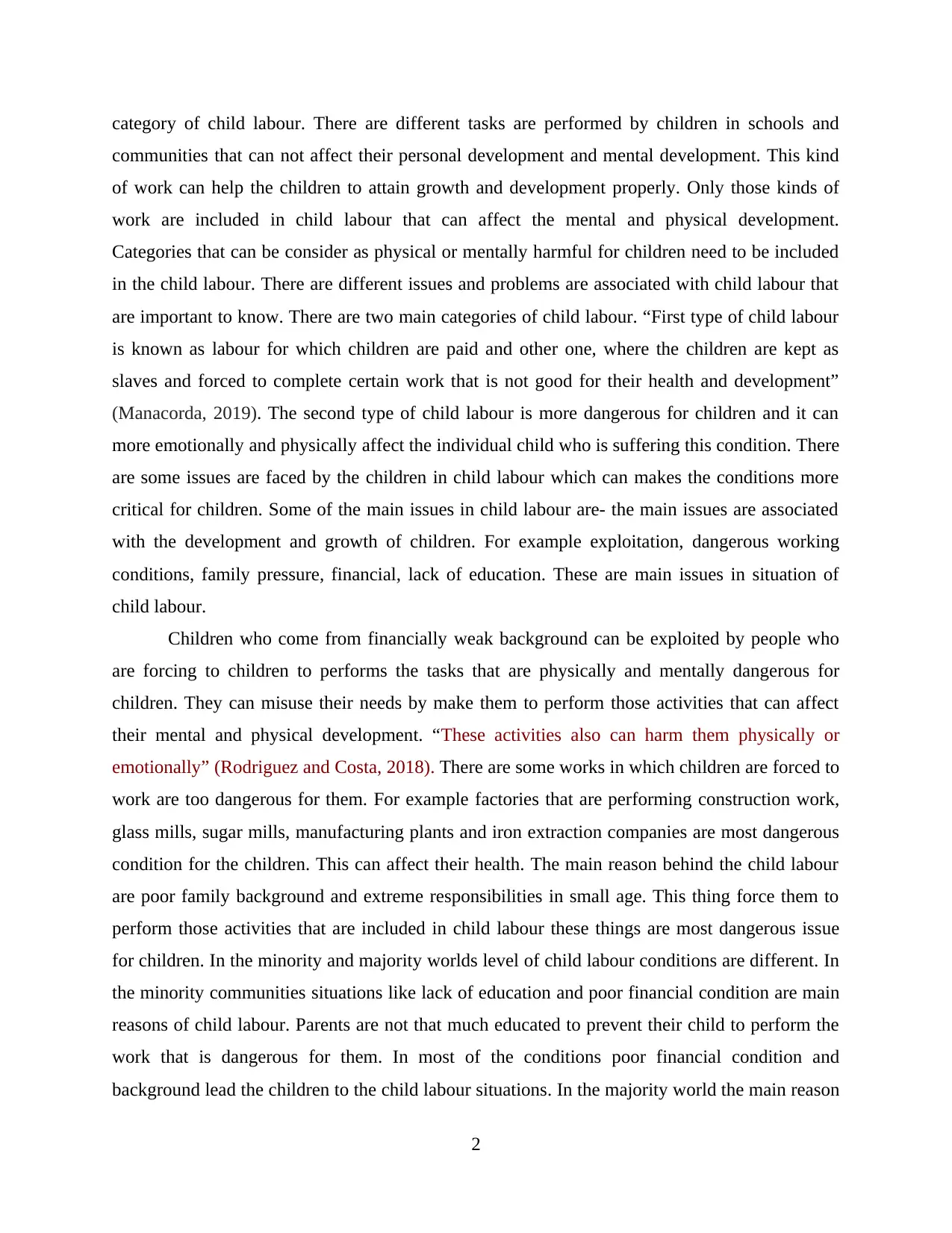
category of child labour. There are different tasks are performed by children in schools and
communities that can not affect their personal development and mental development. This kind
of work can help the children to attain growth and development properly. Only those kinds of
work are included in child labour that can affect the mental and physical development.
Categories that can be consider as physical or mentally harmful for children need to be included
in the child labour. There are different issues and problems are associated with child labour that
are important to know. There are two main categories of child labour. “First type of child labour
is known as labour for which children are paid and other one, where the children are kept as
slaves and forced to complete certain work that is not good for their health and development”
(Manacorda, 2019). The second type of child labour is more dangerous for children and it can
more emotionally and physically affect the individual child who is suffering this condition. There
are some issues are faced by the children in child labour which can makes the conditions more
critical for children. Some of the main issues in child labour are- the main issues are associated
with the development and growth of children. For example exploitation, dangerous working
conditions, family pressure, financial, lack of education. These are main issues in situation of
child labour.
Children who come from financially weak background can be exploited by people who
are forcing to children to performs the tasks that are physically and mentally dangerous for
children. They can misuse their needs by make them to perform those activities that can affect
their mental and physical development. “These activities also can harm them physically or
emotionally” (Rodriguez and Costa, 2018). There are some works in which children are forced to
work are too dangerous for them. For example factories that are performing construction work,
glass mills, sugar mills, manufacturing plants and iron extraction companies are most dangerous
condition for the children. This can affect their health. The main reason behind the child labour
are poor family background and extreme responsibilities in small age. This thing force them to
perform those activities that are included in child labour these things are most dangerous issue
for children. In the minority and majority worlds level of child labour conditions are different. In
the minority communities situations like lack of education and poor financial condition are main
reasons of child labour. Parents are not that much educated to prevent their child to perform the
work that is dangerous for them. In most of the conditions poor financial condition and
background lead the children to the child labour situations. In the majority world the main reason
2
communities that can not affect their personal development and mental development. This kind
of work can help the children to attain growth and development properly. Only those kinds of
work are included in child labour that can affect the mental and physical development.
Categories that can be consider as physical or mentally harmful for children need to be included
in the child labour. There are different issues and problems are associated with child labour that
are important to know. There are two main categories of child labour. “First type of child labour
is known as labour for which children are paid and other one, where the children are kept as
slaves and forced to complete certain work that is not good for their health and development”
(Manacorda, 2019). The second type of child labour is more dangerous for children and it can
more emotionally and physically affect the individual child who is suffering this condition. There
are some issues are faced by the children in child labour which can makes the conditions more
critical for children. Some of the main issues in child labour are- the main issues are associated
with the development and growth of children. For example exploitation, dangerous working
conditions, family pressure, financial, lack of education. These are main issues in situation of
child labour.
Children who come from financially weak background can be exploited by people who
are forcing to children to performs the tasks that are physically and mentally dangerous for
children. They can misuse their needs by make them to perform those activities that can affect
their mental and physical development. “These activities also can harm them physically or
emotionally” (Rodriguez and Costa, 2018). There are some works in which children are forced to
work are too dangerous for them. For example factories that are performing construction work,
glass mills, sugar mills, manufacturing plants and iron extraction companies are most dangerous
condition for the children. This can affect their health. The main reason behind the child labour
are poor family background and extreme responsibilities in small age. This thing force them to
perform those activities that are included in child labour these things are most dangerous issue
for children. In the minority and majority worlds level of child labour conditions are different. In
the minority communities situations like lack of education and poor financial condition are main
reasons of child labour. Parents are not that much educated to prevent their child to perform the
work that is dangerous for them. In most of the conditions poor financial condition and
background lead the children to the child labour situations. In the majority world the main reason
2
Paraphrase This Document
Need a fresh take? Get an instant paraphrase of this document with our AI Paraphraser
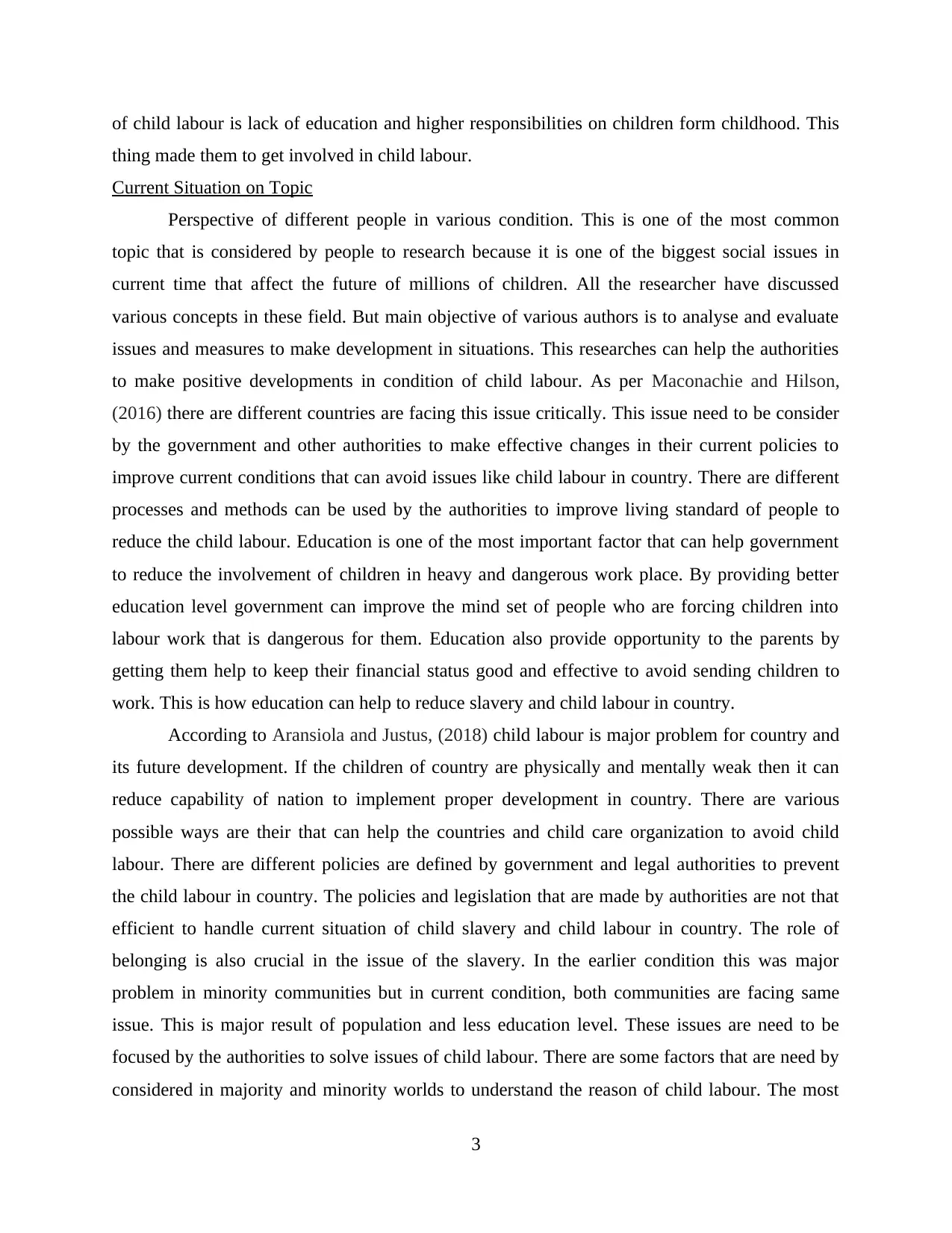
of child labour is lack of education and higher responsibilities on children form childhood. This
thing made them to get involved in child labour.
Current Situation on Topic
Perspective of different people in various condition. This is one of the most common
topic that is considered by people to research because it is one of the biggest social issues in
current time that affect the future of millions of children. All the researcher have discussed
various concepts in these field. But main objective of various authors is to analyse and evaluate
issues and measures to make development in situations. This researches can help the authorities
to make positive developments in condition of child labour. As per Maconachie and Hilson,
(2016) there are different countries are facing this issue critically. This issue need to be consider
by the government and other authorities to make effective changes in their current policies to
improve current conditions that can avoid issues like child labour in country. There are different
processes and methods can be used by the authorities to improve living standard of people to
reduce the child labour. Education is one of the most important factor that can help government
to reduce the involvement of children in heavy and dangerous work place. By providing better
education level government can improve the mind set of people who are forcing children into
labour work that is dangerous for them. Education also provide opportunity to the parents by
getting them help to keep their financial status good and effective to avoid sending children to
work. This is how education can help to reduce slavery and child labour in country.
According to Aransiola and Justus, (2018) child labour is major problem for country and
its future development. If the children of country are physically and mentally weak then it can
reduce capability of nation to implement proper development in country. There are various
possible ways are their that can help the countries and child care organization to avoid child
labour. There are different policies are defined by government and legal authorities to prevent
the child labour in country. The policies and legislation that are made by authorities are not that
efficient to handle current situation of child slavery and child labour in country. The role of
belonging is also crucial in the issue of the slavery. In the earlier condition this was major
problem in minority communities but in current condition, both communities are facing same
issue. This is major result of population and less education level. These issues are need to be
focused by the authorities to solve issues of child labour. There are some factors that are need by
considered in majority and minority worlds to understand the reason of child labour. The most
3
thing made them to get involved in child labour.
Current Situation on Topic
Perspective of different people in various condition. This is one of the most common
topic that is considered by people to research because it is one of the biggest social issues in
current time that affect the future of millions of children. All the researcher have discussed
various concepts in these field. But main objective of various authors is to analyse and evaluate
issues and measures to make development in situations. This researches can help the authorities
to make positive developments in condition of child labour. As per Maconachie and Hilson,
(2016) there are different countries are facing this issue critically. This issue need to be consider
by the government and other authorities to make effective changes in their current policies to
improve current conditions that can avoid issues like child labour in country. There are different
processes and methods can be used by the authorities to improve living standard of people to
reduce the child labour. Education is one of the most important factor that can help government
to reduce the involvement of children in heavy and dangerous work place. By providing better
education level government can improve the mind set of people who are forcing children into
labour work that is dangerous for them. Education also provide opportunity to the parents by
getting them help to keep their financial status good and effective to avoid sending children to
work. This is how education can help to reduce slavery and child labour in country.
According to Aransiola and Justus, (2018) child labour is major problem for country and
its future development. If the children of country are physically and mentally weak then it can
reduce capability of nation to implement proper development in country. There are various
possible ways are their that can help the countries and child care organization to avoid child
labour. There are different policies are defined by government and legal authorities to prevent
the child labour in country. The policies and legislation that are made by authorities are not that
efficient to handle current situation of child slavery and child labour in country. The role of
belonging is also crucial in the issue of the slavery. In the earlier condition this was major
problem in minority communities but in current condition, both communities are facing same
issue. This is major result of population and less education level. These issues are need to be
focused by the authorities to solve issues of child labour. There are some factors that are need by
considered in majority and minority worlds to understand the reason of child labour. The most
3
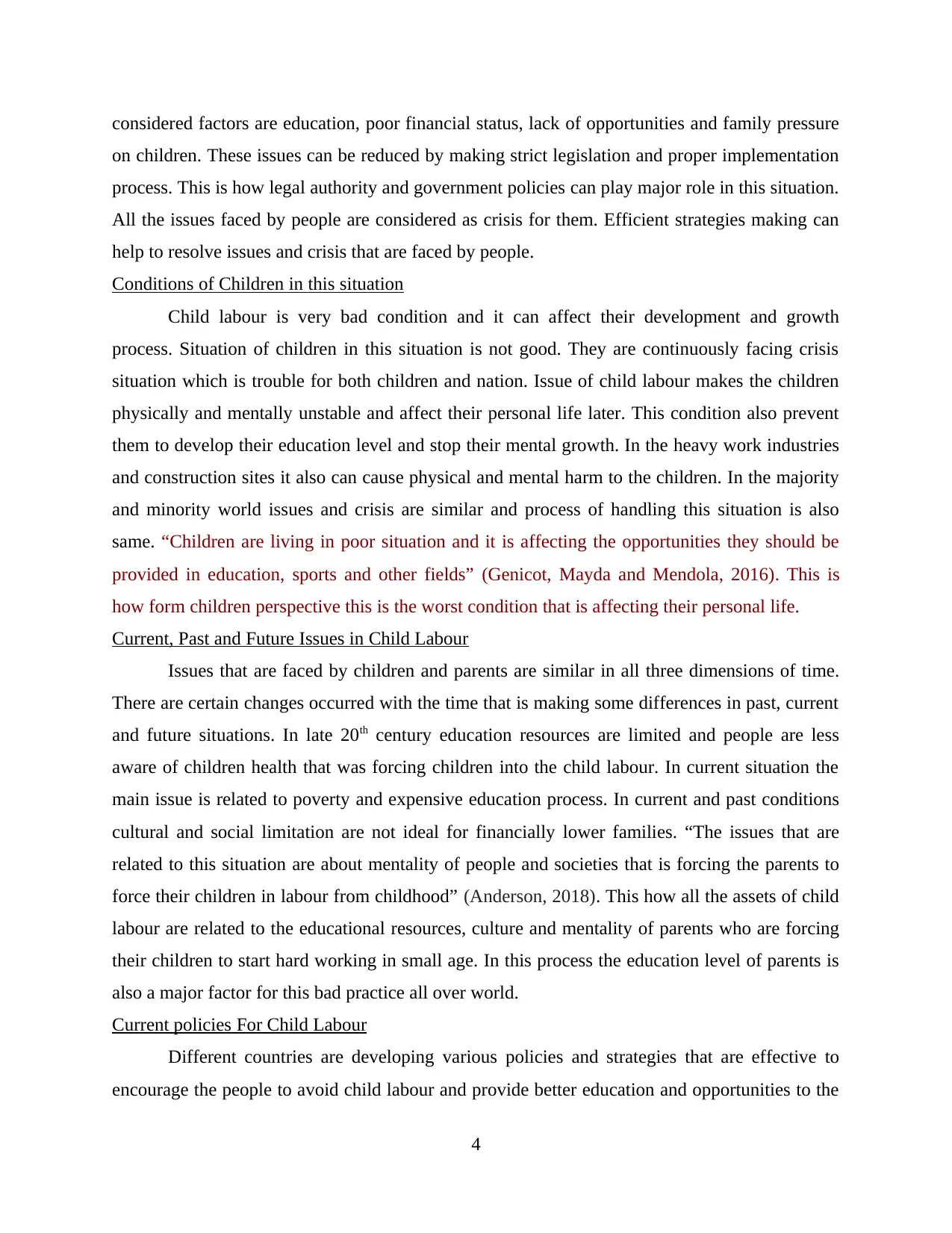
considered factors are education, poor financial status, lack of opportunities and family pressure
on children. These issues can be reduced by making strict legislation and proper implementation
process. This is how legal authority and government policies can play major role in this situation.
All the issues faced by people are considered as crisis for them. Efficient strategies making can
help to resolve issues and crisis that are faced by people.
Conditions of Children in this situation
Child labour is very bad condition and it can affect their development and growth
process. Situation of children in this situation is not good. They are continuously facing crisis
situation which is trouble for both children and nation. Issue of child labour makes the children
physically and mentally unstable and affect their personal life later. This condition also prevent
them to develop their education level and stop their mental growth. In the heavy work industries
and construction sites it also can cause physical and mental harm to the children. In the majority
and minority world issues and crisis are similar and process of handling this situation is also
same. “Children are living in poor situation and it is affecting the opportunities they should be
provided in education, sports and other fields” (Genicot, Mayda and Mendola, 2016). This is
how form children perspective this is the worst condition that is affecting their personal life.
Current, Past and Future Issues in Child Labour
Issues that are faced by children and parents are similar in all three dimensions of time.
There are certain changes occurred with the time that is making some differences in past, current
and future situations. In late 20th century education resources are limited and people are less
aware of children health that was forcing children into the child labour. In current situation the
main issue is related to poverty and expensive education process. In current and past conditions
cultural and social limitation are not ideal for financially lower families. “The issues that are
related to this situation are about mentality of people and societies that is forcing the parents to
force their children in labour from childhood” (Anderson, 2018). This how all the assets of child
labour are related to the educational resources, culture and mentality of parents who are forcing
their children to start hard working in small age. In this process the education level of parents is
also a major factor for this bad practice all over world.
Current policies For Child Labour
Different countries are developing various policies and strategies that are effective to
encourage the people to avoid child labour and provide better education and opportunities to the
4
on children. These issues can be reduced by making strict legislation and proper implementation
process. This is how legal authority and government policies can play major role in this situation.
All the issues faced by people are considered as crisis for them. Efficient strategies making can
help to resolve issues and crisis that are faced by people.
Conditions of Children in this situation
Child labour is very bad condition and it can affect their development and growth
process. Situation of children in this situation is not good. They are continuously facing crisis
situation which is trouble for both children and nation. Issue of child labour makes the children
physically and mentally unstable and affect their personal life later. This condition also prevent
them to develop their education level and stop their mental growth. In the heavy work industries
and construction sites it also can cause physical and mental harm to the children. In the majority
and minority world issues and crisis are similar and process of handling this situation is also
same. “Children are living in poor situation and it is affecting the opportunities they should be
provided in education, sports and other fields” (Genicot, Mayda and Mendola, 2016). This is
how form children perspective this is the worst condition that is affecting their personal life.
Current, Past and Future Issues in Child Labour
Issues that are faced by children and parents are similar in all three dimensions of time.
There are certain changes occurred with the time that is making some differences in past, current
and future situations. In late 20th century education resources are limited and people are less
aware of children health that was forcing children into the child labour. In current situation the
main issue is related to poverty and expensive education process. In current and past conditions
cultural and social limitation are not ideal for financially lower families. “The issues that are
related to this situation are about mentality of people and societies that is forcing the parents to
force their children in labour from childhood” (Anderson, 2018). This how all the assets of child
labour are related to the educational resources, culture and mentality of parents who are forcing
their children to start hard working in small age. In this process the education level of parents is
also a major factor for this bad practice all over world.
Current policies For Child Labour
Different countries are developing various policies and strategies that are effective to
encourage the people to avoid child labour and provide better education and opportunities to the
4
⊘ This is a preview!⊘
Do you want full access?
Subscribe today to unlock all pages.

Trusted by 1+ million students worldwide
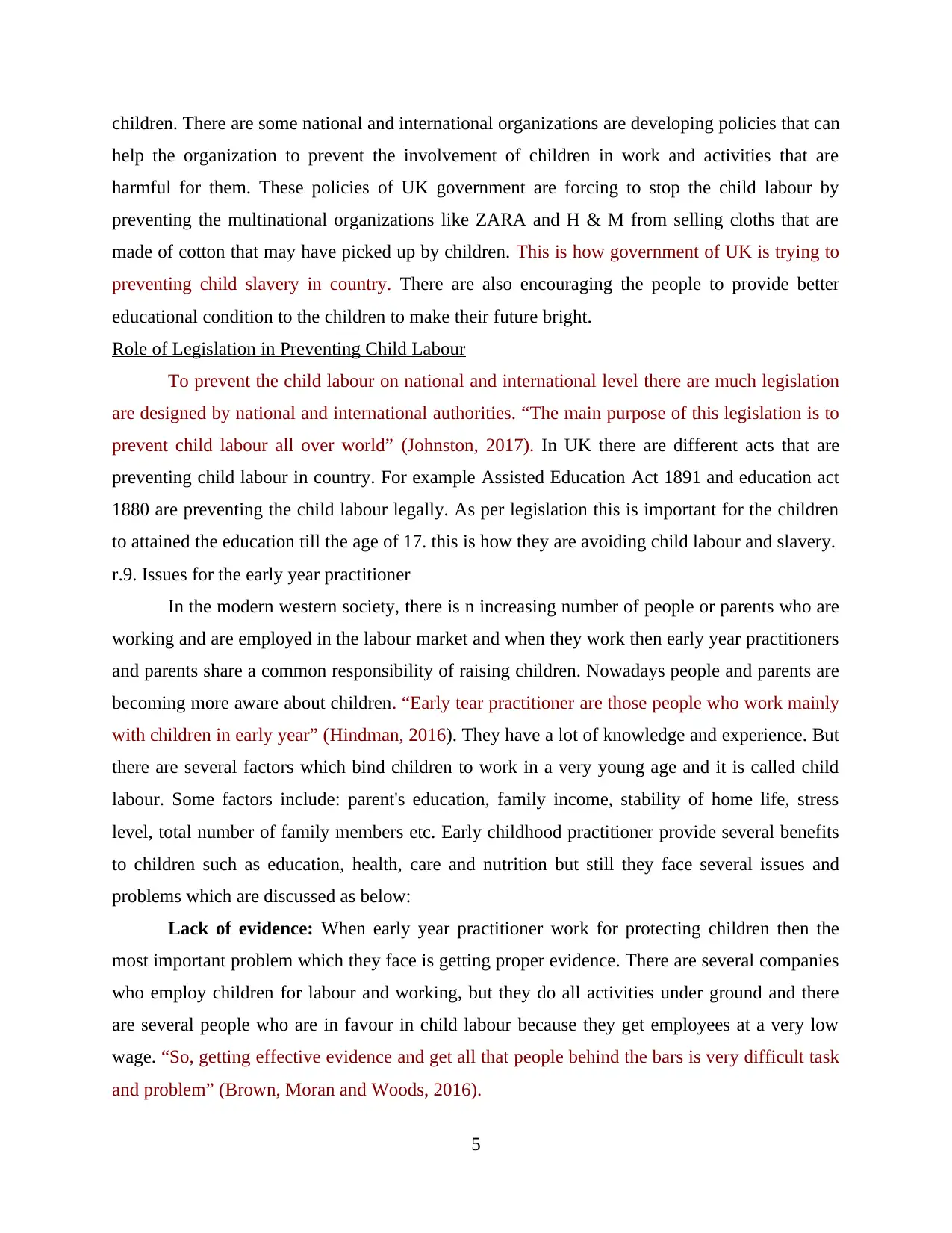
children. There are some national and international organizations are developing policies that can
help the organization to prevent the involvement of children in work and activities that are
harmful for them. These policies of UK government are forcing to stop the child labour by
preventing the multinational organizations like ZARA and H & M from selling cloths that are
made of cotton that may have picked up by children. This is how government of UK is trying to
preventing child slavery in country. There are also encouraging the people to provide better
educational condition to the children to make their future bright.
Role of Legislation in Preventing Child Labour
To prevent the child labour on national and international level there are much legislation
are designed by national and international authorities. “The main purpose of this legislation is to
prevent child labour all over world” (Johnston, 2017). In UK there are different acts that are
preventing child labour in country. For example Assisted Education Act 1891 and education act
1880 are preventing the child labour legally. As per legislation this is important for the children
to attained the education till the age of 17. this is how they are avoiding child labour and slavery.
r.9. Issues for the early year practitioner
In the modern western society, there is n increasing number of people or parents who are
working and are employed in the labour market and when they work then early year practitioners
and parents share a common responsibility of raising children. Nowadays people and parents are
becoming more aware about children. “Early tear practitioner are those people who work mainly
with children in early year” (Hindman, 2016). They have a lot of knowledge and experience. But
there are several factors which bind children to work in a very young age and it is called child
labour. Some factors include: parent's education, family income, stability of home life, stress
level, total number of family members etc. Early childhood practitioner provide several benefits
to children such as education, health, care and nutrition but still they face several issues and
problems which are discussed as below:
Lack of evidence: When early year practitioner work for protecting children then the
most important problem which they face is getting proper evidence. There are several companies
who employ children for labour and working, but they do all activities under ground and there
are several people who are in favour in child labour because they get employees at a very low
wage. “So, getting effective evidence and get all that people behind the bars is very difficult task
and problem” (Brown, Moran and Woods, 2016).
5
help the organization to prevent the involvement of children in work and activities that are
harmful for them. These policies of UK government are forcing to stop the child labour by
preventing the multinational organizations like ZARA and H & M from selling cloths that are
made of cotton that may have picked up by children. This is how government of UK is trying to
preventing child slavery in country. There are also encouraging the people to provide better
educational condition to the children to make their future bright.
Role of Legislation in Preventing Child Labour
To prevent the child labour on national and international level there are much legislation
are designed by national and international authorities. “The main purpose of this legislation is to
prevent child labour all over world” (Johnston, 2017). In UK there are different acts that are
preventing child labour in country. For example Assisted Education Act 1891 and education act
1880 are preventing the child labour legally. As per legislation this is important for the children
to attained the education till the age of 17. this is how they are avoiding child labour and slavery.
r.9. Issues for the early year practitioner
In the modern western society, there is n increasing number of people or parents who are
working and are employed in the labour market and when they work then early year practitioners
and parents share a common responsibility of raising children. Nowadays people and parents are
becoming more aware about children. “Early tear practitioner are those people who work mainly
with children in early year” (Hindman, 2016). They have a lot of knowledge and experience. But
there are several factors which bind children to work in a very young age and it is called child
labour. Some factors include: parent's education, family income, stability of home life, stress
level, total number of family members etc. Early childhood practitioner provide several benefits
to children such as education, health, care and nutrition but still they face several issues and
problems which are discussed as below:
Lack of evidence: When early year practitioner work for protecting children then the
most important problem which they face is getting proper evidence. There are several companies
who employ children for labour and working, but they do all activities under ground and there
are several people who are in favour in child labour because they get employees at a very low
wage. “So, getting effective evidence and get all that people behind the bars is very difficult task
and problem” (Brown, Moran and Woods, 2016).
5
Paraphrase This Document
Need a fresh take? Get an instant paraphrase of this document with our AI Paraphraser
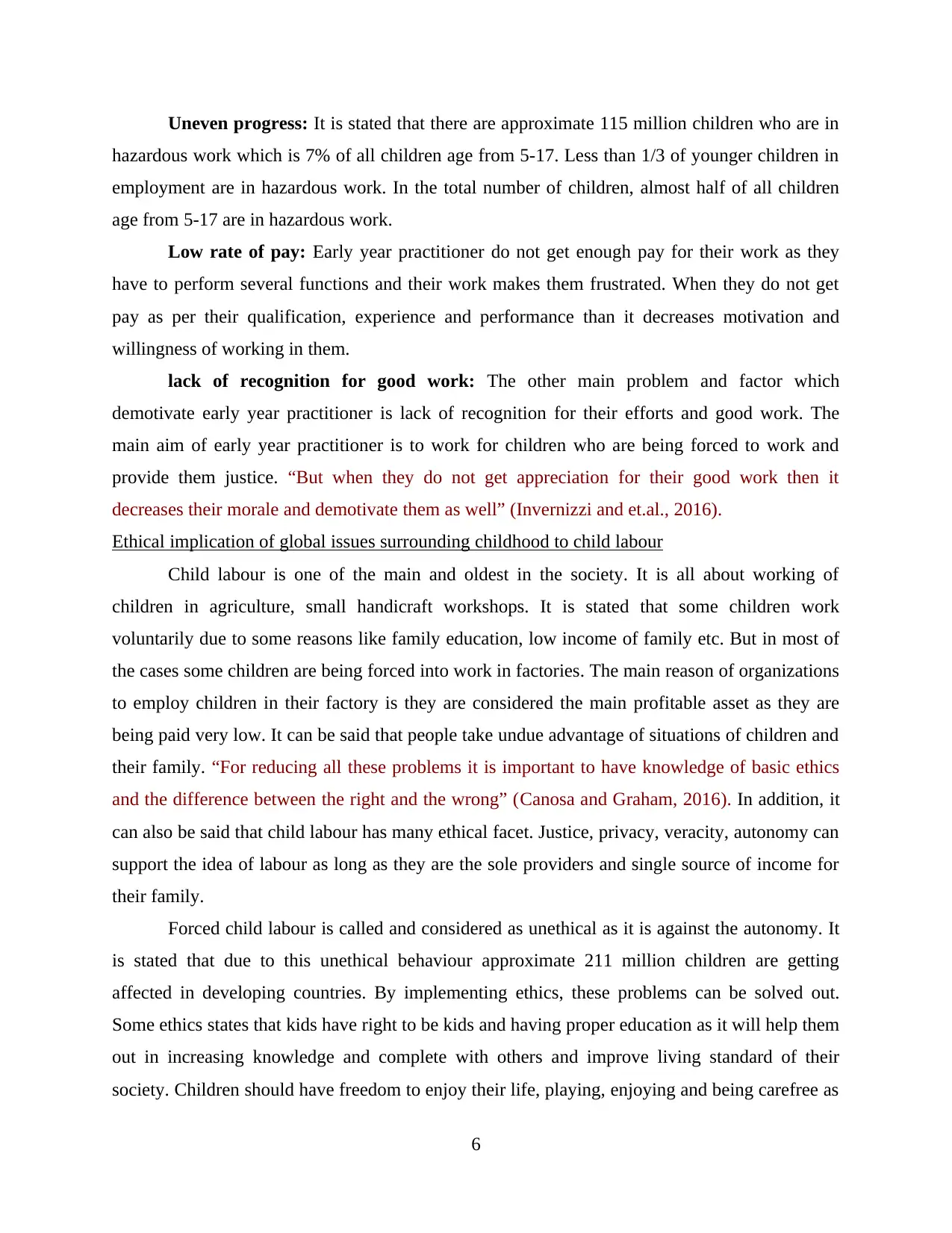
Uneven progress: It is stated that there are approximate 115 million children who are in
hazardous work which is 7% of all children age from 5-17. Less than 1/3 of younger children in
employment are in hazardous work. In the total number of children, almost half of all children
age from 5-17 are in hazardous work.
Low rate of pay: Early year practitioner do not get enough pay for their work as they
have to perform several functions and their work makes them frustrated. When they do not get
pay as per their qualification, experience and performance than it decreases motivation and
willingness of working in them.
lack of recognition for good work: The other main problem and factor which
demotivate early year practitioner is lack of recognition for their efforts and good work. The
main aim of early year practitioner is to work for children who are being forced to work and
provide them justice. “But when they do not get appreciation for their good work then it
decreases their morale and demotivate them as well” (Invernizzi and et.al., 2016).
Ethical implication of global issues surrounding childhood to child labour
Child labour is one of the main and oldest in the society. It is all about working of
children in agriculture, small handicraft workshops. It is stated that some children work
voluntarily due to some reasons like family education, low income of family etc. But in most of
the cases some children are being forced into work in factories. The main reason of organizations
to employ children in their factory is they are considered the main profitable asset as they are
being paid very low. It can be said that people take undue advantage of situations of children and
their family. “For reducing all these problems it is important to have knowledge of basic ethics
and the difference between the right and the wrong” (Canosa and Graham, 2016). In addition, it
can also be said that child labour has many ethical facet. Justice, privacy, veracity, autonomy can
support the idea of labour as long as they are the sole providers and single source of income for
their family.
Forced child labour is called and considered as unethical as it is against the autonomy. It
is stated that due to this unethical behaviour approximate 211 million children are getting
affected in developing countries. By implementing ethics, these problems can be solved out.
Some ethics states that kids have right to be kids and having proper education as it will help them
out in increasing knowledge and complete with others and improve living standard of their
society. Children should have freedom to enjoy their life, playing, enjoying and being carefree as
6
hazardous work which is 7% of all children age from 5-17. Less than 1/3 of younger children in
employment are in hazardous work. In the total number of children, almost half of all children
age from 5-17 are in hazardous work.
Low rate of pay: Early year practitioner do not get enough pay for their work as they
have to perform several functions and their work makes them frustrated. When they do not get
pay as per their qualification, experience and performance than it decreases motivation and
willingness of working in them.
lack of recognition for good work: The other main problem and factor which
demotivate early year practitioner is lack of recognition for their efforts and good work. The
main aim of early year practitioner is to work for children who are being forced to work and
provide them justice. “But when they do not get appreciation for their good work then it
decreases their morale and demotivate them as well” (Invernizzi and et.al., 2016).
Ethical implication of global issues surrounding childhood to child labour
Child labour is one of the main and oldest in the society. It is all about working of
children in agriculture, small handicraft workshops. It is stated that some children work
voluntarily due to some reasons like family education, low income of family etc. But in most of
the cases some children are being forced into work in factories. The main reason of organizations
to employ children in their factory is they are considered the main profitable asset as they are
being paid very low. It can be said that people take undue advantage of situations of children and
their family. “For reducing all these problems it is important to have knowledge of basic ethics
and the difference between the right and the wrong” (Canosa and Graham, 2016). In addition, it
can also be said that child labour has many ethical facet. Justice, privacy, veracity, autonomy can
support the idea of labour as long as they are the sole providers and single source of income for
their family.
Forced child labour is called and considered as unethical as it is against the autonomy. It
is stated that due to this unethical behaviour approximate 211 million children are getting
affected in developing countries. By implementing ethics, these problems can be solved out.
Some ethics states that kids have right to be kids and having proper education as it will help them
out in increasing knowledge and complete with others and improve living standard of their
society. Children should have freedom to enjoy their life, playing, enjoying and being carefree as
6
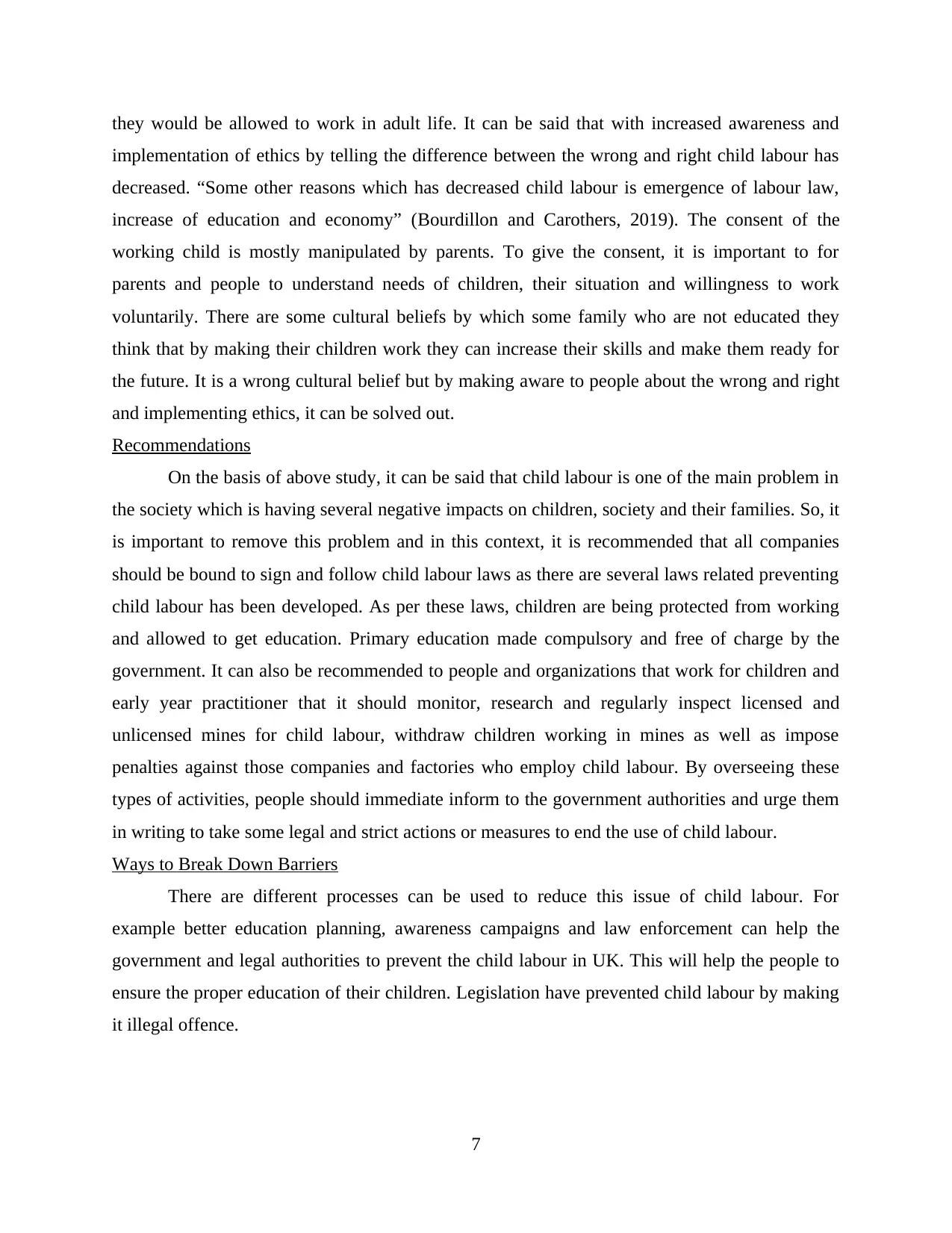
they would be allowed to work in adult life. It can be said that with increased awareness and
implementation of ethics by telling the difference between the wrong and right child labour has
decreased. “Some other reasons which has decreased child labour is emergence of labour law,
increase of education and economy” (Bourdillon and Carothers, 2019). The consent of the
working child is mostly manipulated by parents. To give the consent, it is important to for
parents and people to understand needs of children, their situation and willingness to work
voluntarily. There are some cultural beliefs by which some family who are not educated they
think that by making their children work they can increase their skills and make them ready for
the future. It is a wrong cultural belief but by making aware to people about the wrong and right
and implementing ethics, it can be solved out.
Recommendations
On the basis of above study, it can be said that child labour is one of the main problem in
the society which is having several negative impacts on children, society and their families. So, it
is important to remove this problem and in this context, it is recommended that all companies
should be bound to sign and follow child labour laws as there are several laws related preventing
child labour has been developed. As per these laws, children are being protected from working
and allowed to get education. Primary education made compulsory and free of charge by the
government. It can also be recommended to people and organizations that work for children and
early year practitioner that it should monitor, research and regularly inspect licensed and
unlicensed mines for child labour, withdraw children working in mines as well as impose
penalties against those companies and factories who employ child labour. By overseeing these
types of activities, people should immediate inform to the government authorities and urge them
in writing to take some legal and strict actions or measures to end the use of child labour.
Ways to Break Down Barriers
There are different processes can be used to reduce this issue of child labour. For
example better education planning, awareness campaigns and law enforcement can help the
government and legal authorities to prevent the child labour in UK. This will help the people to
ensure the proper education of their children. Legislation have prevented child labour by making
it illegal offence.
7
implementation of ethics by telling the difference between the wrong and right child labour has
decreased. “Some other reasons which has decreased child labour is emergence of labour law,
increase of education and economy” (Bourdillon and Carothers, 2019). The consent of the
working child is mostly manipulated by parents. To give the consent, it is important to for
parents and people to understand needs of children, their situation and willingness to work
voluntarily. There are some cultural beliefs by which some family who are not educated they
think that by making their children work they can increase their skills and make them ready for
the future. It is a wrong cultural belief but by making aware to people about the wrong and right
and implementing ethics, it can be solved out.
Recommendations
On the basis of above study, it can be said that child labour is one of the main problem in
the society which is having several negative impacts on children, society and their families. So, it
is important to remove this problem and in this context, it is recommended that all companies
should be bound to sign and follow child labour laws as there are several laws related preventing
child labour has been developed. As per these laws, children are being protected from working
and allowed to get education. Primary education made compulsory and free of charge by the
government. It can also be recommended to people and organizations that work for children and
early year practitioner that it should monitor, research and regularly inspect licensed and
unlicensed mines for child labour, withdraw children working in mines as well as impose
penalties against those companies and factories who employ child labour. By overseeing these
types of activities, people should immediate inform to the government authorities and urge them
in writing to take some legal and strict actions or measures to end the use of child labour.
Ways to Break Down Barriers
There are different processes can be used to reduce this issue of child labour. For
example better education planning, awareness campaigns and law enforcement can help the
government and legal authorities to prevent the child labour in UK. This will help the people to
ensure the proper education of their children. Legislation have prevented child labour by making
it illegal offence.
7
⊘ This is a preview!⊘
Do you want full access?
Subscribe today to unlock all pages.

Trusted by 1+ million students worldwide
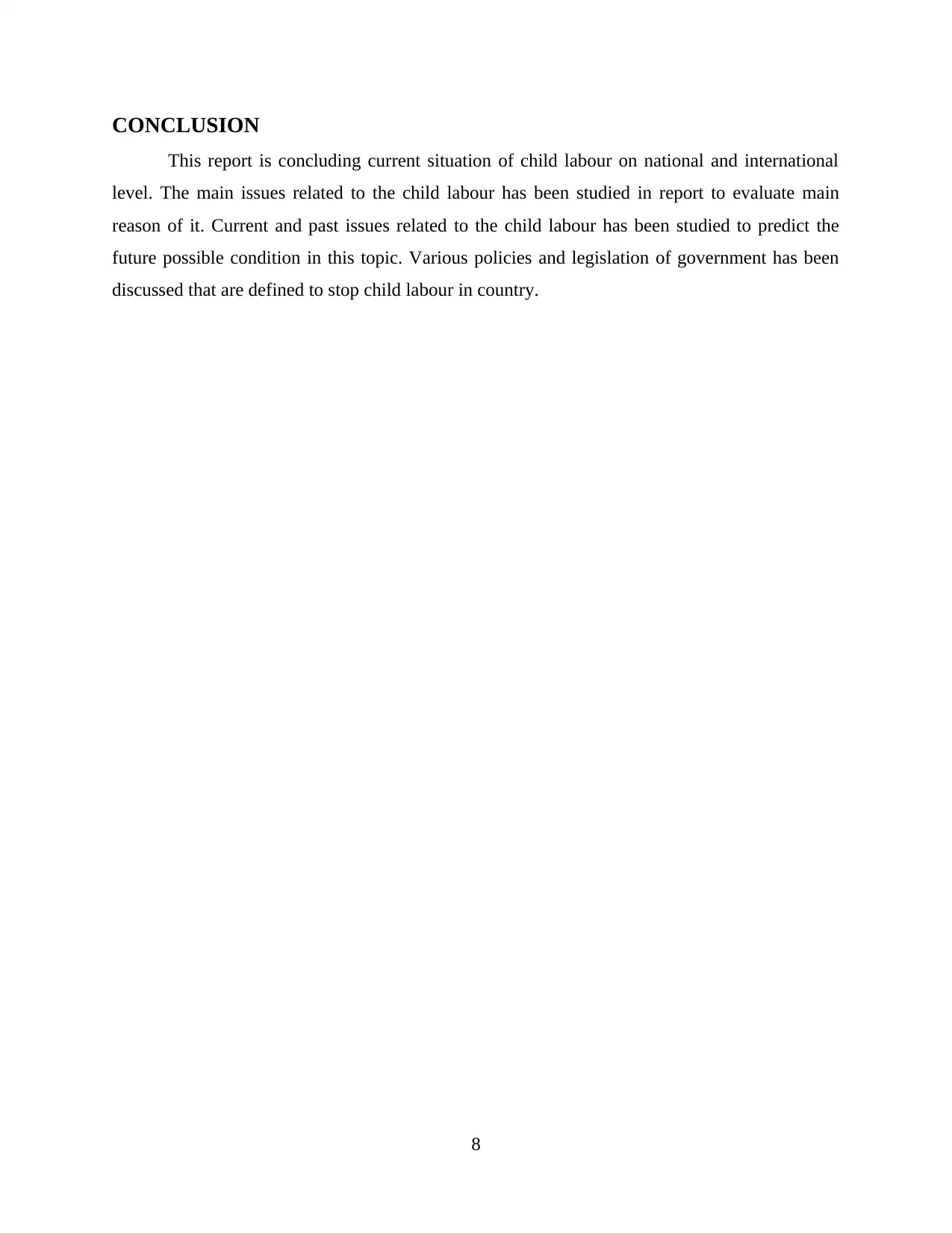
CONCLUSION
This report is concluding current situation of child labour on national and international
level. The main issues related to the child labour has been studied in report to evaluate main
reason of it. Current and past issues related to the child labour has been studied to predict the
future possible condition in this topic. Various policies and legislation of government has been
discussed that are defined to stop child labour in country.
8
This report is concluding current situation of child labour on national and international
level. The main issues related to the child labour has been studied in report to evaluate main
reason of it. Current and past issues related to the child labour has been studied to predict the
future possible condition in this topic. Various policies and legislation of government has been
discussed that are defined to stop child labour in country.
8
Paraphrase This Document
Need a fresh take? Get an instant paraphrase of this document with our AI Paraphraser
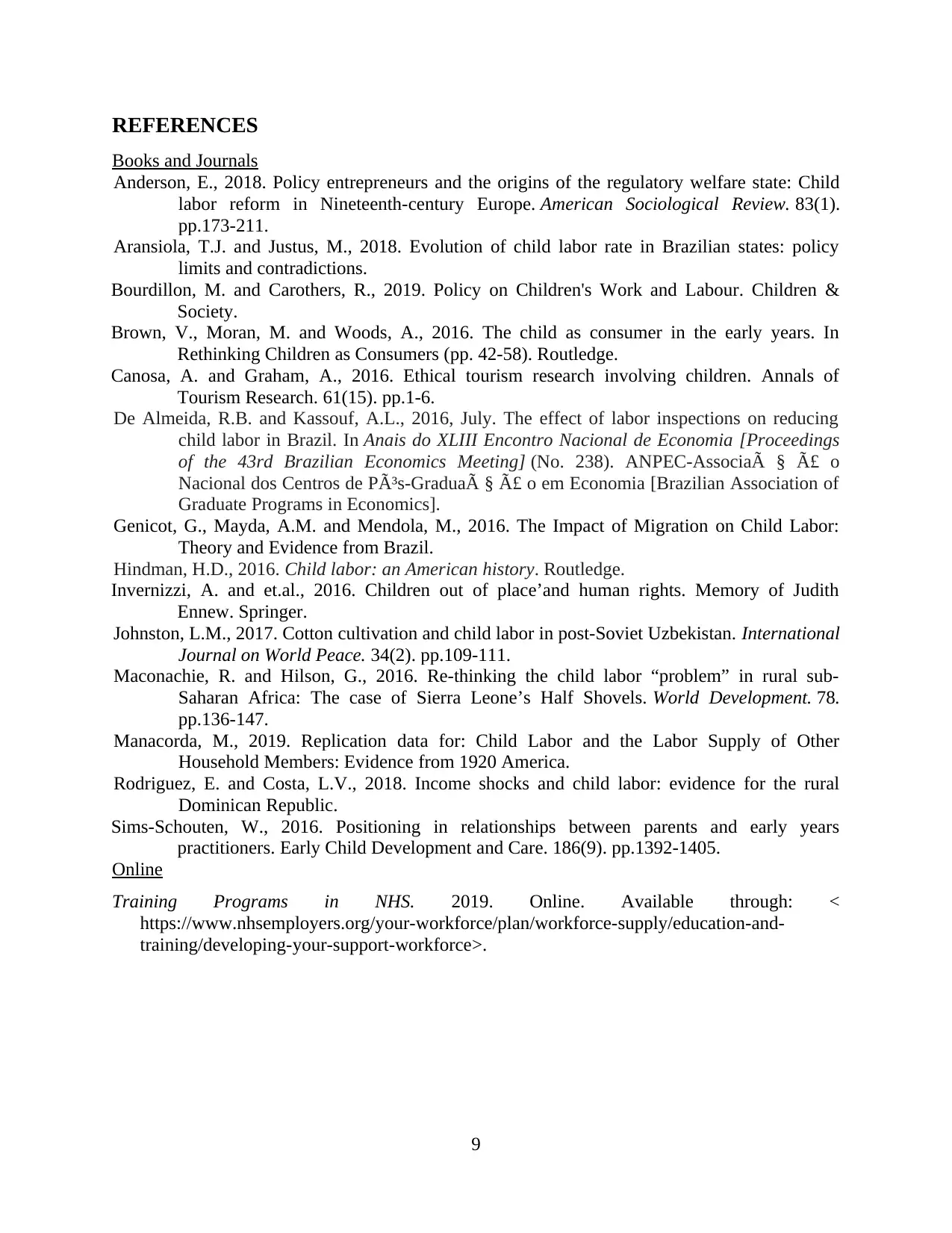
REFERENCES
Books and Journals
Anderson, E., 2018. Policy entrepreneurs and the origins of the regulatory welfare state: Child
labor reform in Nineteenth-century Europe. American Sociological Review. 83(1).
pp.173-211.
Aransiola, T.J. and Justus, M., 2018. Evolution of child labor rate in Brazilian states: policy
limits and contradictions.
Bourdillon, M. and Carothers, R., 2019. Policy on Children's Work and Labour. Children &
Society.
Brown, V., Moran, M. and Woods, A., 2016. The child as consumer in the early years. In
Rethinking Children as Consumers (pp. 42-58). Routledge.
Canosa, A. and Graham, A., 2016. Ethical tourism research involving children. Annals of
Tourism Research. 61(15). pp.1-6.
De Almeida, R.B. and Kassouf, A.L., 2016, July. The effect of labor inspections on reducing
child labor in Brazil. In Anais do XLIII Encontro Nacional de Economia [Proceedings
of the 43rd Brazilian Economics Meeting] (No. 238). ANPEC-Associaà § ã o
Nacional dos Centros de Pós-Graduaà § ã o em Economia [Brazilian Association of
Graduate Programs in Economics].
Genicot, G., Mayda, A.M. and Mendola, M., 2016. The Impact of Migration on Child Labor:
Theory and Evidence from Brazil.
Hindman, H.D., 2016. Child labor: an American history. Routledge.
Invernizzi, A. and et.al., 2016. Children out of place’and human rights. Memory of Judith
Ennew. Springer.
Johnston, L.M., 2017. Cotton cultivation and child labor in post-Soviet Uzbekistan. International
Journal on World Peace. 34(2). pp.109-111.
Maconachie, R. and Hilson, G., 2016. Re-thinking the child labor “problem” in rural sub-
Saharan Africa: The case of Sierra Leone’s Half Shovels. World Development. 78.
pp.136-147.
Manacorda, M., 2019. Replication data for: Child Labor and the Labor Supply of Other
Household Members: Evidence from 1920 America.
Rodriguez, E. and Costa, L.V., 2018. Income shocks and child labor: evidence for the rural
Dominican Republic.
Sims-Schouten, W., 2016. Positioning in relationships between parents and early years
practitioners. Early Child Development and Care. 186(9). pp.1392-1405.
Online
Training Programs in NHS. 2019. Online. Available through: <
https://www.nhsemployers.org/your-workforce/plan/workforce-supply/education-and-
training/developing-your-support-workforce>.
9
Books and Journals
Anderson, E., 2018. Policy entrepreneurs and the origins of the regulatory welfare state: Child
labor reform in Nineteenth-century Europe. American Sociological Review. 83(1).
pp.173-211.
Aransiola, T.J. and Justus, M., 2018. Evolution of child labor rate in Brazilian states: policy
limits and contradictions.
Bourdillon, M. and Carothers, R., 2019. Policy on Children's Work and Labour. Children &
Society.
Brown, V., Moran, M. and Woods, A., 2016. The child as consumer in the early years. In
Rethinking Children as Consumers (pp. 42-58). Routledge.
Canosa, A. and Graham, A., 2016. Ethical tourism research involving children. Annals of
Tourism Research. 61(15). pp.1-6.
De Almeida, R.B. and Kassouf, A.L., 2016, July. The effect of labor inspections on reducing
child labor in Brazil. In Anais do XLIII Encontro Nacional de Economia [Proceedings
of the 43rd Brazilian Economics Meeting] (No. 238). ANPEC-Associaà § ã o
Nacional dos Centros de Pós-Graduaà § ã o em Economia [Brazilian Association of
Graduate Programs in Economics].
Genicot, G., Mayda, A.M. and Mendola, M., 2016. The Impact of Migration on Child Labor:
Theory and Evidence from Brazil.
Hindman, H.D., 2016. Child labor: an American history. Routledge.
Invernizzi, A. and et.al., 2016. Children out of place’and human rights. Memory of Judith
Ennew. Springer.
Johnston, L.M., 2017. Cotton cultivation and child labor in post-Soviet Uzbekistan. International
Journal on World Peace. 34(2). pp.109-111.
Maconachie, R. and Hilson, G., 2016. Re-thinking the child labor “problem” in rural sub-
Saharan Africa: The case of Sierra Leone’s Half Shovels. World Development. 78.
pp.136-147.
Manacorda, M., 2019. Replication data for: Child Labor and the Labor Supply of Other
Household Members: Evidence from 1920 America.
Rodriguez, E. and Costa, L.V., 2018. Income shocks and child labor: evidence for the rural
Dominican Republic.
Sims-Schouten, W., 2016. Positioning in relationships between parents and early years
practitioners. Early Child Development and Care. 186(9). pp.1392-1405.
Online
Training Programs in NHS. 2019. Online. Available through: <
https://www.nhsemployers.org/your-workforce/plan/workforce-supply/education-and-
training/developing-your-support-workforce>.
9
1 out of 11
Related Documents
Your All-in-One AI-Powered Toolkit for Academic Success.
+13062052269
info@desklib.com
Available 24*7 on WhatsApp / Email
![[object Object]](/_next/static/media/star-bottom.7253800d.svg)
Unlock your academic potential
Copyright © 2020–2025 A2Z Services. All Rights Reserved. Developed and managed by ZUCOL.




